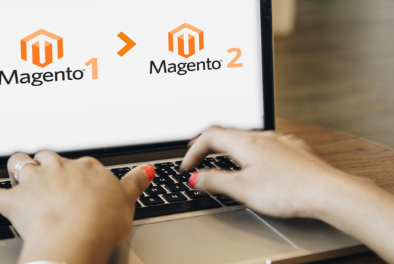Migrating to the latest Magento versions
In recent years Magento has evolved from being a solid stand-alone eCommerce platform to being part of one of the most complex end-to-end solutions available on the market, as the engine that powers Adobe Commerce. The product that we see now is the newest Magento 2 version, improved and refined over the course of the last 5 years. This begs the question: what happens to Magento 1 users, where do they stand now and what is the best course of action?
If you want to find out more about this release, we are here to help.
Although Adobe announced the EOL for Magento 1 in June 2020 and no longer supports it, a majority of Magento websites continue to use it. As the stats show it, it is not a small number. In fact, there are over 80000 sites using Magento 1.9 or lower, almost 30% of the total number of all Magento sites.

At the time it was launched, Magento 1 was indeed built with a defining feature in mind – flexibility. Unfortunately, focusing on flexibility didn’t make it the most user-friendly, high-performing platform. There were important tools missing right “out of the box” that every store needed, such as performance optimization, mobile-responsiveness, and admin capabilities.
The release of Magento 2 in 2015 sent waves through the Magento community, as it promised to fix old issues. And it surely delivered plenty. For starters, the performance increased and Magento 2 sites run with an average of 20% faster, encouraging more sales and having a great impact on SEO. Full-page caching ensures that pages load a lot faster and catalog pages are handled better, without slow downs, an essential feat for large stores that plan to grow.
The checkout process in Magento 2 is more streamlined, making it quicker and easier for customers to go from cart to completed order, thus reducing abandoned carts.
Magento 2 also integrates a lot of popular extensions, so stores have better functionality out of the box.
The new admin interface is more user-friendly and designed to help reduce the time managing an online store. At the same time, recognizing the way customers, Magento 2 has made mobile responsiveness a priority. It comes with new responsively designed themes, integrated video, and easier checkout. These all improve the look and function of Magento stores on mobile devices, thus encouraging mobile sales.
But the biggest benefit over its predecessor is the emphasys Magento 2 is placing on security. With security patches released frequently, Magento 2 is making sure that their platform offers peace of mind for its users.
Despite the undeniable improvements, more than 80000 users still feel that Magento 1 is suitable for their ecommerce needs. The prominent reason is that changing to the new platform is not a simple upgrade. Magento 2 is essentially a different platform and switching to it requires a complete rebuild and some online store owners simply aren’t ready for this yet. At the same time, there are Magento 1 users who are satisfied with how the platform works for their store. To add to this, extension providers are slowly transitioning to Magento 2, so it’s possible that there are still extensions without a Magento 2 version. In this case, users might be waiting for their favorite extension to be compatible until they switch over.
No matter the reasons, running your site on Magento 1 is a bet nobody should be willing to take. As of June 2020, running an unsupported version of Magento is a security risk and means that the website using it is no longer PCI compliant and should not accept online payments. All payment processing companies are urgently advising merchants to migrate to a PCI compliant platform. Not to mention that in time, many of the old modules will not be updated, and might not work properly.
We always love to talk about eCommerce so if you need information about our products and services, we are here to help.
Migrating to Magento 2 – key steps and timeline
Migrating to Magento 2 is not an easy process, as it comes with a completely different architecture and database design. The process will likely take from three to a few months, depending on the number of customizations, complexity, and the number of extensions a store has. That is why companies need to plan it extensively, to understand if more advanced functionality is required at that time or in the future.

Broadly speaking, migration means a few steps. First, we will need to install Magento 2 and set up the Magento 2 store with a similar topology and design to the Magento 1 store. The actual migration will then take place, starting with configuration settings and the main data in the database. Migrating media files such as images must be done differently than product data. Media data will need to be migrated manually. Magento 1 extensions are most likely not compatible with Magento 2 and they must be re-created to work properly with the new Magento 2 structure. The whole process will end with updating incremental data such as new orders, reviews and changes in customer profiles that happened during the migration process, and move them to the new Magento 2 store.
Of course, the process might not work as fluidly and despite planning, issues might occur. But in the hands of the right developers, migrating to the newest version of Magento should not pose a challenge.
Magento 2 was launched in 2015 and since then, it has been updated constantly. This has brought up a new problem for merchants who chose the 2.x version but have not kept up with the updates.
Migrating from earlier versions of Magento 2 to the most recent ones can often be very problematic, as the differences in code and database are consistent.
There were a few times when we had to upgrade to version 2.3 or 2.4 and, because of these consistent differences, we chose not to take the usual path recommended in devdocs, using Composer. A core upgrade made through Composer would have generated junk code and data, which in time would have created different problems and required all sorts of patches.
Instead, one solution was to keep the old database and install a clean Magento, then link to the old database and run a deployment this way. Another solution in the past was to completely give up code and database and install a completely new Magento with both new code and database, then export attributes, attribute sets, products, categories, customers, orders, sales, invoices, credit memos, etc. and import them into the new database.
With small interventions on some data, they can be exported / imported very simply through mysql only, without the need to implement an export / import script.
With every update project, we recommend our customers to keep close to each Magento upgrade and not let too much time pass.
The more Magento evolves, there are consistent changes in both code and database, and the more difficult and time consuming an upgrade becomes. The risks increase, and of course, the costs will be higher.
If you want to know more about our list of services at Clever++, please visit our website.




